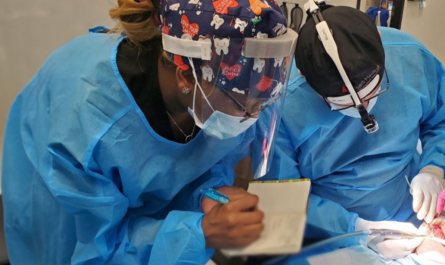Achieving Practice Efficiency with Multi-Disciplinary Care Teams
In today’s dental practices, it is becoming more difficult to manage the challenges of closing the gap between science research (best practice) and optimum patient care. Many patients still see dentistry as an elective service and not the preventative medicine it truly is. With that in mind, patients could present with medical problems that could delay, prolong, or even rule out dental treatments they want or need due to other priorities in their medical health. This is unlike a medical case synopsis, which makes it easy for doctors to execute a prescribed path of care based on best practices – such as kidney disease, which immediately requires some form of dialysis without any negotiation from the patient. Dentistry has and always will allow for a unique approach and conversation with each patient in their decision-making process for their desired outcome.
Dr. John Kois, director of the Kois Center, teaches his members to ask: Are patients trying to create a smile they once had or one they have never had? In dentistry, a risk assessment is determined at an initial appointment when gathering information and all of the diagnostics needed to create a case synopsis for optimum outcomes for the patient. As these recommendations for preventive, functional, and esthetic goals are discussed in depth with the patient, the patient and dentist prioritize treatments based on the most realistic outcomes.
Patients desire the best available care provided by a qualified, multi-disciplinary team of professionals and specialists who are part of their general dentist’s collaborative circle in order to realize for the most economical investment and greatest value. Success in being efficient and obtaining optimum results for the patient can only be achieved with a team that is committed, coordinated, possesses clear communication skills, and cares. Delivering safe, lasting treatments must be paramount while still maintaining a well-trained internal support team with an eco-system that will withstand any type of patient needs, maintain a focus of closing the gap between scientific research and patient care delivery, and sustaining practice profitability.
To move toward mastering an eco-system in the culture of any practice, systems and strategies must be created and maintained, with each procedure provided to the patient, without exception. Supporting technology is the catalyst for an efficient eco-system in the culture of each practice. This includes, but is not limited to, all diagnostic technology, practice management software, data processing and documentation, and a system for all providers on the multi-disciplinary care team to virtually review and discuss the case synopsis and their part in care delivery. It also includes a shared portal through which the internal support team eco-system can communicate and track patient progress throughout the entire patient experience of preparation and post care. This allows a more efficient transfer of information and care and, as a result, more patients will be satisfied and feel they not only made the right decision, but they are apt to refer others who desire the same outcome level that they obtained.
A practice structure that has shown promising results is that of the multi-disciplinary care team committed to excellence through best practice scenarios. These multi-disciplinary care teams should be formed and function with a “zero tolerance” attitude for mediocrity that surrounds and drive them to achieve consistent execution. The right place, people, processes, and technology are integrated and utilized efficiently and effectively.
Approaching efficiency in a practice
Efficiency in the practice will be important in the future as a result of society’s shifting focus toward prolonged health and the realization that oral health is a significant factor in overall health. Once this preventative mindset is instilled in patients, they will demand practices that offer a consistently effective, streamlined standard of care with accurate diagnostic record-keeping and patient information that can be quickly and easily shared among everyone involved in their treatment.
An efficient internal support team has commitment to the process and will work diligently to reinforce the new paradigm through repeated opportunities as more patients are processed with a focus of closing the gap between scientific research and patient care delivery. They also will consistently demonstrate a “zero tolerance” in every step to ensure continuity of use of all supporting technology that will enhance the quality of their dentistry. This is usually measured by every practice’s profitability margin. The internal support team’s motive to step-up mastering efficiency in functioning each day will be equal to their individual desire for purpose and autonomy in their job. Many will undergo creative training and development particular to working in these types of practices, and they understand that effective and efficient communication is the core of being a part of an excellent multi-disciplinary care team.
The ability to record, save, and instantly share information with all involved team members provides the ability for everyone to collaborate. This facilitates the best practice approach to care based on screening, prevention, education/behavior modification, routine care, serious care, chronic illness/pain management, or restorative care. This means that patients can be treated as efficiently as possible, which in some cases may be important to their immediate health.
To become efficient there are basic steps a practice can complete. First, be sure to have large capacity people as your internal support team able to understand and function in a multi-disciplinary setting. Secondly, an eco-system for all processes, from hello to good-bye, is necessary. Establish in-service training and education to make sure practice management software and all charting, notes, and documentation protocol penetrate the soul of the practice for excellent risk management and maximized outcome in communication with all specialists on the care team. Then, assess what the patient experience is like in your practice – from their perspective.
Ask yourself if you are providing a thorough risk assessment of each patient’s case, a comprehensive evaluation, case synopsis, and treatment strategy. Always engage the patient in the decisions about their dentistry and health based on a clear vision of “why” they want what they want. The practice culture dictates what experiences the patient will have and how the patient interrupts those experiences throughout their care sequence. The key to efficiency in this aspect is making certain that the patient is heard, engaged, encouraged, comfortable, and that the planned care sequence will provide the outcome that shouts, an “extraordinary” experience. This will increase the relationship equity built with the patient, thereby increasing value proposition and increased referrals. Lastly, the impetus behind the efficiency mindset – the supporting technology – must be fully utilized within a multi-disciplinary care setting. This is because, at times, a multi-disciplinary care team member may be at a remote location; utilizing a mobile device puts them “in the same room” with the patient or other team members.
The role of multi-disciplinary care teams
In the dental practice, a multi-disciplinary care team is a group of dental doctors and sometimes medical specialists dedicated to closing the translational medicine gap between science and care, through service delivery innovation. However, as with any practice, the doctors are only a part of the equation. The medical/dental assistants, hygienists, management, and internal support team members in every location must all work cohesively and collaboratively in concert to achieve efficiency. This is accomplished when all members of the team understand and uphold the values of multi-disciplinary care by delivering the highest standard of care quickly and effectively, and accurately documenting all aspects of the patient’s health/treatments so all team members have the same information pertaining to each patient. This is the value proposition at its best to each patient.
This structure presents a no ceiling, no limits level of comprehensive care in one setting, in the least amount of time, with the greatest value proposition to the patient. When your practice functions at optimal speed with minimal risk, you can affect measurable differences in a patient’s health and well-being. The practice benefits from increased referral rates, a much higher level of case acceptance via the “value proposition,” and the completion of more cases due to a better relationship with patients.
Moving to the future
The most important key for unlocking the future of your multi-disciplinary care teams in more practices is to keep in mind the components of the value proposition to patients and care delivery innovation. Choose team members who are willing to perform their duties without mediocrity on a daily basis. They can be found or developed anywhere with a consistent template of care. Make certain your treatment rooms are systematically equipped, stocked, and laid-out for versatility and efficient time management, the highest productivity, and equal treatment capability.
Create a sustainable eco-system of care protocols for any and all functions performed in your practice. Dr. John Kois has coined, “Always Rule,” doing things the same way all the time for optimum outcomes in the least amount of time. Guessing, at any level of treatment, wastes time and money. Lastly, keep technology congruent and current with practice needs, care team needs, and patient expectations, and be sure to utilize all available supportive technology with each existing patient and every new patient.
Choose to be extraordinary at every touch point your patient will encounter, from hello to good-bye. Providing this structured, consistent, and optimized level of care will increase your patient base and team solidarity as they learn, grow, and serve with a greater capacity to care. How will you know it is working? Profitability is the measurement of innovative thinkers coming together to execute efficiently that which is needed by both the multi-disciplinary care team and the value proposition of each patient daily, if not hourly.
Sidebar:
Drive for perfection
Multi-disciplinary care teams should be formed and function with a “zero tolerance” attitude for mediocrity that surrounds and drives them to achieve consistent execution.
On the record
The ability to record, save, and instantly share information with all involved team members provides the ability for everyone to collaborate
Are you providing…
A thorough risk assessment of each patient’s case? A comprehensive evaluation case synopsis, and treatment strategy?





